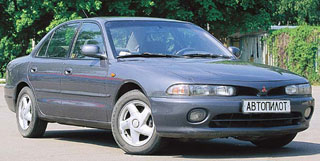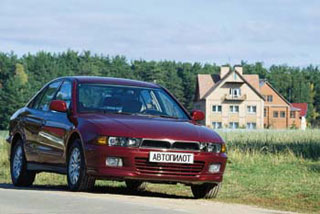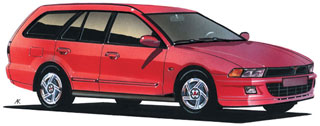Test drive Mitsubishi Galant 1997 - 2004 sedan
Fixed and supplemented
 Another update in the Mitsubishi Motors gamut. Galant was subjected to him, which we have the top of the line of the corporation (a higher -class Mitsubishi Sigma does not come to us). What has changed in comparison with the model, which is already two years old - and is not successful - sold in Russia? We have to use the imported word faslifting (the tightening of the face somehow does not sound), since the main differences are on the surface, while the internal content of the car can be described as follows: fixed and supplemented.
Another update in the Mitsubishi Motors gamut. Galant was subjected to him, which we have the top of the line of the corporation (a higher -class Mitsubishi Sigma does not come to us). What has changed in comparison with the model, which is already two years old - and is not successful - sold in Russia? We have to use the imported word faslifting (the tightening of the face somehow does not sound), since the main differences are on the surface, while the internal content of the car can be described as follows: fixed and supplemented. We took the new Mitsubishi Galant test, equipped with a 2.5 liter with a gasoline engine and an automatic INVECS-II transmission.
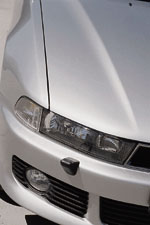 About appearance. The car received a new front bumper with built -in, rather original, fog of an elliptical shape and a slightly modified hood with more developed stampings that stretch from metallized air intake cladding. Changes in the front of the body gave the appearance of this shark on wheels even more predatory and aggressiveness.
About appearance. The car received a new front bumper with built -in, rather original, fog of an elliptical shape and a slightly modified hood with more developed stampings that stretch from metallized air intake cladding. Changes in the front of the body gave the appearance of this shark on wheels even more predatory and aggressiveness. 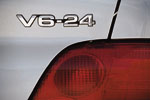 External lighting equipment has changed. The obligatory orange light of the rotation signals and the side repeaters hid deep into it, giving way to white glass fashionable now - on a silver metal car, this looks very impressive. The rear lights received two elliptical lenses - reverse lanterns and fog.
External lighting equipment has changed. The obligatory orange light of the rotation signals and the side repeaters hid deep into it, giving way to white glass fashionable now - on a silver metal car, this looks very impressive. The rear lights received two elliptical lenses - reverse lanterns and fog. 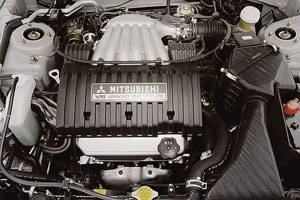 About what is hidden from the eye. The main news is the appearance in the gamut of the GDI gasoline engine (with direct injection) of a 2.4 -liter working volume. Previously, the GDI motor (it was also put on Carisma), the volume of 1.8 liters had, now Galant decided to equip it with a power unit more suitable for its status. However, this news is not for us. As Russian buyers in the salons of official Mitsubishi dealers did not see the Galant Model with the GDI nameplate over the side re -turning repeater, they will not see. The solution to the issue of the supply of such cars is directly related to the known quality of motor fuel at Russian gas stations.
About what is hidden from the eye. The main news is the appearance in the gamut of the GDI gasoline engine (with direct injection) of a 2.4 -liter working volume. Previously, the GDI motor (it was also put on Carisma), the volume of 1.8 liters had, now Galant decided to equip it with a power unit more suitable for its status. However, this news is not for us. As Russian buyers in the salons of official Mitsubishi dealers did not see the Galant Model with the GDI nameplate over the side re -turning repeater, they will not see. The solution to the issue of the supply of such cars is directly related to the known quality of motor fuel at Russian gas stations. Other engines remained the same. These are two -liter in -line fours - gasoline with ordinary multi -point injection and turbodiesel, as well as a V -shaped six with a volume of 2.5 liters (motor E 12, 1997). All gasoline motors have four valves per cylinder, the diesel engine is enough and two. As for the transmission, an InVECS-II adaptive automatic box appeared here with the possibility of security gearboxes manually. The chassis remained unchanged - multi -link independent suspensions in front and behind with stabilizers of the anti -resistance stability.
 Let's see what happened to the interior. The salon has not changed at all, the upholstery of seats and inserts on the sidewalls of the doors are fabric (our current Galant is in cheaper configuration than the one we experienced two years ago - everything was made of leather there). The driver's seat is now regulated manually (for the same reason), which does not interfere with the convenient position at the wheel. All handles are carried on the side of the pillows on the door side, this facilitates the movement of the chair both sitting in it and located next to the car. Between the front seats appeared a armrest with cup holders hidden in the lid, and under it a container formed for small objects.
Let's see what happened to the interior. The salon has not changed at all, the upholstery of seats and inserts on the sidewalls of the doors are fabric (our current Galant is in cheaper configuration than the one we experienced two years ago - everything was made of leather there). The driver's seat is now regulated manually (for the same reason), which does not interfere with the convenient position at the wheel. All handles are carried on the side of the pillows on the door side, this facilitates the movement of the chair both sitting in it and located next to the car. Between the front seats appeared a armrest with cup holders hidden in the lid, and under it a container formed for small objects. 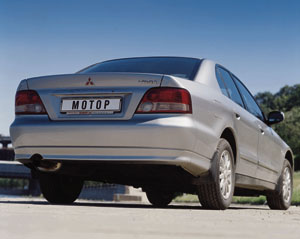 In the trunk now there are cavities for road trifles and a pen on the inside of the lid - for the convenience of closing, especially in dirty weather.
In the trunk now there are cavities for road trifles and a pen on the inside of the lid - for the convenience of closing, especially in dirty weather. We return to the salon. The chair holds well. The landing is quite high, and then at the steering column the adjustment range along the angle of inclination turned out to be insufficient - I just want to raise the steering wheel higher. Well, where is the combination of devices?
Somewhere in the depths of dark glass - barely prominent numbers and arrows of analog indicators. Something is wrong here. We launch the engine, and everything became literally clear - the Christmas tree lit up. The brightness of the lighting of the devices can be adjusted. A characteristic of Mitsubishi cars with a slightly bluish icy tint glow in daytime conditions - as if the usual white on black.
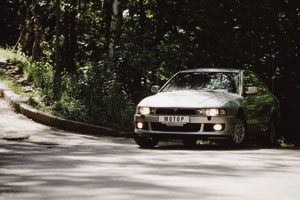 In the middle of the combination, between the tachometer and the speedometer, the letter indicator of the automatic transmission modes is located, under it the numbers from 1 to 4 - they work when the Sports Mode manual mode is turned on. Four digits - four passes forward. And where is the neutral and the back? It turns out that in manual mode to turn on the reverse, you need to return to the machine.
In the middle of the combination, between the tachometer and the speedometer, the letter indicator of the automatic transmission modes is located, under it the numbers from 1 to 4 - they work when the Sports Mode manual mode is turned on. Four digits - four passes forward. And where is the neutral and the back? It turns out that in manual mode to turn on the reverse, you need to return to the machine. Recently, there is a stable trend: on models (usually higher than the middle class) with automatic transmission, the driver has the opportunity to switch the transmission manually. Even American cars that were always considered a stronghold of automatism could not avoid this. European - and even more so. We already drove a car with a similar transmission last year - it was an Audi A6 with a Tiptronic box - so to speak, the ancestor of the genre. Now here is the adaptive automate inVecs-II from Mitsubishi.
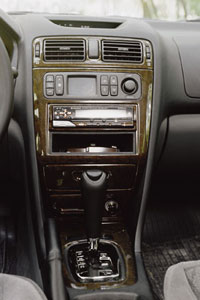 It is impossible to forget the handbrake - its raised lever reliably blocks the path to the box selector. The leg - to the brake pedals (otherwise you can’t move the selector lever), press the convenient button of the lever lock button with his thumb and put it into position D. The car shudders slightly. You release the brake - let's go. The engine obediently and quickly gaining momentum, after reaching about 2500 rpm. There is a shift in the gears - almost without reminders about yourself, without jerks and subsequent stepping engine pickles. The work of the transmission is given only by the arrow of the tachometer.
It is impossible to forget the handbrake - its raised lever reliably blocks the path to the box selector. The leg - to the brake pedals (otherwise you can’t move the selector lever), press the convenient button of the lever lock button with his thumb and put it into position D. The car shudders slightly. You release the brake - let's go. The engine obediently and quickly gaining momentum, after reaching about 2500 rpm. There is a shift in the gears - almost without reminders about yourself, without jerks and subsequent stepping engine pickles. The work of the transmission is given only by the arrow of the tachometer.  The car begins to move back too briskly, which gave a reason to suspect the gas pedal in low sensitivity, but when driving in the direct direction, the accelerator acts very clearly, the machine reacts perfectly to any pushing on the intensity.
The car begins to move back too briskly, which gave a reason to suspect the gas pedal in low sensitivity, but when driving in the direct direction, the accelerator acts very clearly, the machine reacts perfectly to any pushing on the intensity. Actually, with the learning of the InVecs-II box, we are familiar. It is interesting to see how she behaves manually. We stop and translate the lever from position D to the right (if this is done on the go, nothing bad will happen, just on the indicator, opposite the numbers that corresponds to the stage turned on at that moment, the light will light up). The lever leaned, pulling his hand far - a little unusual. The stereotype is triggered, and it seems that you will switch from the fifth to the back or vice versa.
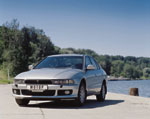 The indicator reports that the first gear is enabled. We touch as in ordinary automatic mode and click on gas. The arrow of the tachometer obediently goes up, the car accelerates, the sound of the exhaust is already clearly serious ... The revolutionary limiter worked for 6.5 thousand. Well, if you go manually, if you please work with a lever.
The indicator reports that the first gear is enabled. We touch as in ordinary automatic mode and click on gas. The arrow of the tachometer obediently goes up, the car accelerates, the sound of the exhaust is already clearly serious ... The revolutionary limiter worked for 6.5 thousand. Well, if you go manually, if you please work with a lever. We quickly turn on the second - followed by a noticeable jerk in the transmission. Due to the fact that the limiter dropped momentum? Let's try again. I reset the momentum (the transition to the first convinced the possibility of braking by the engine), I accelerate again and turn on the second without discharge of gas. A jerk is noticeably weaker. We are going on. The third gear turned on with an even less noticeable jerk, and the fourth completely flowed from the third smoothly. When you get used to that your hand has to reach out to the right of usual, everything is very nothing. No machine is needed ...
 Braking. The car slows down not so intensively. As we would like - you have to increase the effort on the pedals. Perhaps there are enough brakes on less powerful versions of Galant, but here their effectiveness could be increased. While studying the work of the brake system, the box of the quietly sank to the second gear. A complete stop leads to the transition to the first, while the engine is not going to stall at all.
Braking. The car slows down not so intensively. As we would like - you have to increase the effort on the pedals. Perhaps there are enough brakes on less powerful versions of Galant, but here their effectiveness could be increased. While studying the work of the brake system, the box of the quietly sank to the second gear. A complete stop leads to the transition to the first, while the engine is not going to stall at all.  The suspension was slightly surprised. She does not knock on sharp potholes, the car gently overcomes small irregularities, but after that it sways for a long time - as if you lie on a mattress filled with water. It seems to be a little more, and rinses. Vertical fluctuations are extinguished uncertainly, when shooting, when I, at the request of the photographer, calmly rearranged Galant from place to place, the car almost struck the bottom. But they drove only along a dirt road. The most interesting thing is that the car at the same time obeys the steering wheel well, demonstrates the commendable accuracy of the movement along the set trajectory and a typical front -wheel drive behavior. It is unclear where such chassis from the chassis came from - adaptation to Russian conditions or, perhaps, the desire to increase the comfort of the car? I remember that two years ago this was not.
The suspension was slightly surprised. She does not knock on sharp potholes, the car gently overcomes small irregularities, but after that it sways for a long time - as if you lie on a mattress filled with water. It seems to be a little more, and rinses. Vertical fluctuations are extinguished uncertainly, when shooting, when I, at the request of the photographer, calmly rearranged Galant from place to place, the car almost struck the bottom. But they drove only along a dirt road. The most interesting thing is that the car at the same time obeys the steering wheel well, demonstrates the commendable accuracy of the movement along the set trajectory and a typical front -wheel drive behavior. It is unclear where such chassis from the chassis came from - adaptation to Russian conditions or, perhaps, the desire to increase the comfort of the car? I remember that two years ago this was not.  Acquaintance with the updated Mitsubishi Galant took place. Progress, as they say, is evident, and the new transmission came to the court. If you get used to the peculiar behavior of the suspension, then the machine is quite suitable for the role of the city individual vehicle of the high class. And you can get used to almost everything.
Acquaintance with the updated Mitsubishi Galant took place. Progress, as they say, is evident, and the new transmission came to the court. If you get used to the peculiar behavior of the suspension, then the machine is quite suitable for the role of the city individual vehicle of the high class. And you can get used to almost everything. Peter Ivanitsky
Source: Motor magazine [No. 7/1999]
Video Test Drive Mitsubishi Galant 1997 - 2004
Video Crash tests Mitsubishi Galant 1997 - 2004
Test drives Mitsubishi Galant 1997 - 2004
Malfunctions Mitsubishi Galant 1997 - 2004
Mitsubishi Galant malfunctions: Detailed information| Galant 1997 - 2004 | |
|---|---|
| Engine |  |
| Transmission |  |
| Control system and suspension |  |
| Brake system |  |
| Air heating and air conditioning |  |
| Launch and charging system |  |
| Electric components and so on |  |
| Corrosion body stability |  |










